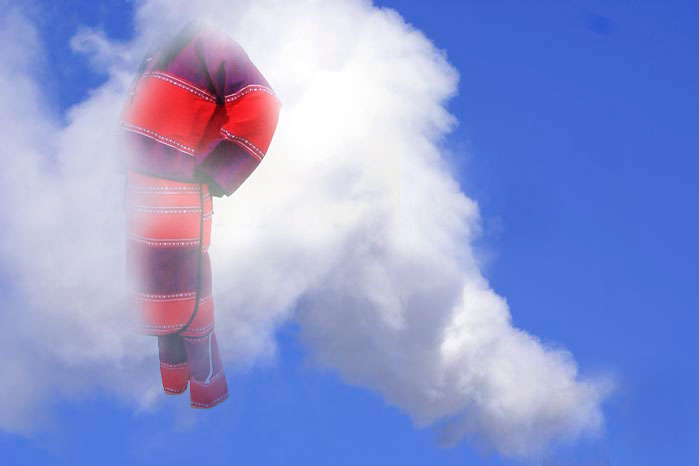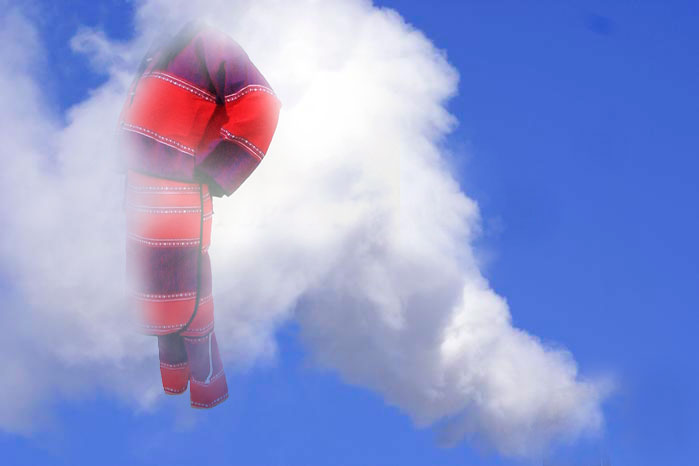Walis Labai (WU Diing-Wuu)

A Walking Spirit of Glory
- 2022, single-channel video, 1 min 50 sec.
- Courtesy of the artist.
Curatorial Perspective
The artist’s name, Walis Labai (WU Diing-Wuu), tells the complex history experienced by individuals and communities throughout the emerging process of the presence of contemporary indigeneity in Taiwan. Born to the given name, WU Diing-Wuu, the artist’s father is a mainlander Chinese veteran, who retreated to Taiwan with the Nationalist government, and his mother is of Sediq descent. During the revitalization movement in the 1980s, he first changed his name to WU Diing-Wuu Walis. Then, in the 1990s, he corrected his name to Walis Labai. Afterwards, he changed it to his current name, Walis Labai (WU Diing-Wuu). This phenomenon of hybridization involving diverse cultures serves as a testimony to the complicated “revitalization” process encountered by indigenous peoples in their quest of the self and identity. In the past twenty years, his creative practice centers on the experiment, exploration, and application of contemporary new media, including digital retouching of historical images and digital composite images. He also creates works by utilizing the technology of grating plates to conceptually hybridize images of plants, rocks, and figures, or by producing projection installations to create simple projections onto giant rocks or lonely cliffs by riversides and in mountains, where people rarely visit. This time, for the “Taiwan Art Biennial,” he specially creates grating plates based on the images of his maternal grandparents, as a continuation of his Invisible Project, while paying tribute to Chinese traditional art with A Shawl of Sediq Huntingman of Landscape Painting, a new project that also beckons the other half of his lineage and identity. On the one hand, Invisible Project points to the history of how colonial tradition has forced tangible lives into hiding, turning them into mere existences in the gathering and writing by anthropologists—a kind of “that-has-been” without history. Or, with consistent yet invisible (micro) discrimination, colonial tradition could continue to sustain the deep traumas suffered by indigenous peoples through generations. On the other hand, the project also hints at the animist beliefs of many indigenous communities around the world, which can be found in everyday rituals, or in origin mythologies depicting the harmonious coexistence among man, ecology, and other species. However, such wisdom about the ecology, which is much needed in the face of environmental crises spreading worldwide, has disappeared gradually from our everyday experiences following the disappearance of indigenous communities.
Creation Description
In the traditional culture of Taiwan’s indigenous Sediq tribe, hunting grounds were determined by the range traveled by hunters in mountain forests. Hunters wore a woven shawl for protection and warmth when hunting or sleeping. Walis Labai (Wu Diing-Wuu) imitates the styles of well-known traditional Chinese ink painters, such as Fan Kuan of the Northern Song dynasty and Zhao Mengfu of the Yuan dynasty, to depict forests, rocks, mountain springs, and low-lying clouds and mist on hunter’s shawls. His intention is to incorporate the concepts of traditional hunting grounds of the Sediq tribe into landscape paintings. Shawls appear like undulating peaks and valleys. As mountains and water colors spread as far and wide as Sediq hunters, this landscape painting becomes complete.
In the series, My Grand Father and Grand Mother are Tree-Born People, photographs of grandparents and images of trees are combined to produce graphic works with movie-like image synthesis effects. The metonymy of these works is based on a legend of Taiwan’s indigenous Sediq people in which it is said that they were born from the roots of a tree, manifesting the most unique “tree-born” life experience of the Sediq cultural matrix and inspiring reflection on the possibilities for modern society to return to simplicity.
The series My Grand Father and Grand Mother are Stone-Born People is based on a legend of Taiwan’s indigenous Sediq tribe. In the Central Mountain Range is a large white boulder, which the Sediq people refer to as Rmdax tasing (stone that shines). It is considered their ancestral birthplace and lies within their hunting territory. This is a sacred stone said to protect and guide Sediq hunters so that they do not become lost in the vast Central Mountain Range. Photographs of grandparents and images of Hehuan Mountain are combined to create graphic works that incorporate image synthesis effects. Based on the metonymy of this legend, an endless love for nature and a desire to return to it are conveyed.
An article of traditional Sediq clothing hangs quietly, as it is projected onto the mist of a waterfall or the curls of smoke from a fire. It has come from somewhere distant and after passing this moment continues forward. A Walking Spirit of Glory tells the world that indigenous peoples are bravely walking in their vision of the future.

